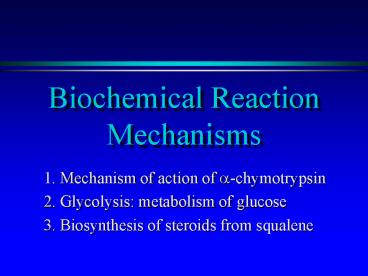Biochemical Reaction Mechanisms - PowerPoint PPT Presentation
1 / 21
Title:
Biochemical Reaction Mechanisms
Description:
3. Biosynthesis of steroids from squalene. Mechanism of action of. a-chymotrypsin ... Biosynthesis of Steroids. from Squalene. Squalene (a shark oil terpene) ... – PowerPoint PPT presentation
Number of Views:381
Avg rating:3.0/5.0
Title: Biochemical Reaction Mechanisms
1
Biochemical Reaction Mechanisms
- 1. Mechanism of action of a-chymotrypsin
- 2. Glycolysis metabolism of glucose
- 3. Biosynthesis of steroids from squalene
2
Mechanism of action ofa-chymotrypsin
- (An enzyme that hydrolyzes peptides in the
digestive system)
3
Catalytic triad Asp102, His 57, Ser 195
4
a-chymotrypsin mechanism
5
a-chymotrypsin mechanism
6
Glycolysis
- Metabolism of glucose to form pyruvate and ATP
7
Glycolysis converts glucose into two pyruvate
molecules
- with the production of 2 ATPs (high energy
storage in cells) - Isomerization of glucose to fructose
- Formation of iminium ion retro aldol to form two
3-carbon sugars (as phosphates) - Isomerization of dihydroxyacetone to
glyceraldehyde (as phosphates) - Oxidation, isomerization, dehydration and
dephosphorylation to form pyruvate and ATP
8
Isomerization of glucose to fructose
9
Iminium ion retro aldol addition
10
Isomerization to glyceraldehyde
11
Oxidation, isomerization and dephosphorylation
(ATP forming)
12
Biosynthesis of Steroids from Squalene
13
Squalene (a shark oil terpene)
14
Epoxidation of Squalene
15
Acid-Catalyzed Epoxide Ring Opening A Ring
Formation
A
16
Reaction of Alkene with Carbocation B Ring
A
B
A
17
Cyclization to form C Ring
B
A
C
A
B
18
Cyclization to form D Ring
C
D
A
B
19
Hydride and Methyl Shifts
20
Eventually...Cholesterol !
21
Grading / Final Exam
Example
- You may replace any of the 5 tests by an
improved grade on that section of the Exam. - Only the higher grade counts.
- You need not retake a section if you are happy
with your grade on that test. - Everyone must take Section 6 (Ch 25, 26, 27 29)
plus Section 7 (comprehensive mostly synthesis)
Your (best) score on these seven sections
plus the sum of your gla scores determines your
grade.































